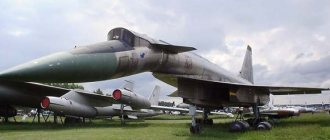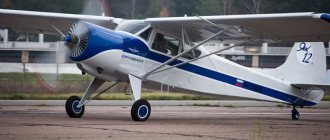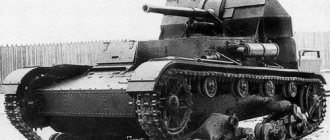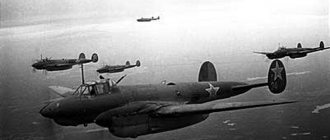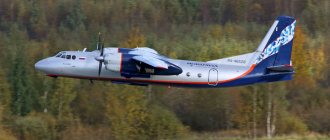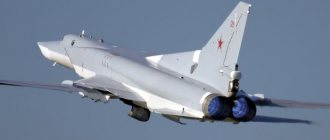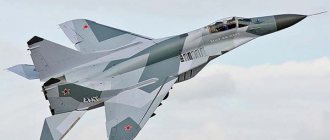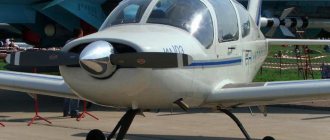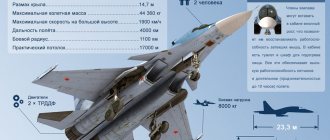More information about modifications of the TB-3 aircraft
ANT-6 - prototype - 1930 - with Curtis-Conqueror engines (600 hp). After tests carried out in February 1931, BMW-VI engines (730 hp) with enlarged radiators, like on the R-6 aircraft, were installed. Instead of horn compensation for ailerons, slot compensation was introduced; the area of the horizontal tail has been increased; imported wheels, which turned out to be weak, were replaced with domestic ones, located in tandem bogies; a rifle turret was suspended under each wing console; installed small arms, mounted beam-type bomb racks; made changes to radio and electrical equipment.
TB-3 4M-17 - heavy bomber in flight. USSR, 30s.
TB-3 - 4M-17F serial. Preparations for production began in the second half of 1931 at two factories. The first production vehicle showed a significant increase in take-off weight. As a result of the measures taken, the airframe was lightened by more than 800 kg.
| TB-3 bombers | |
| Click image for a larger view | |
TB-3 - 4M-34. The airframe design is left unchanged. Honeycomb radiators were installed in the hoods of a new shape, while being significantly shifted back - under the wing. After the release of several dozen vehicles in February 1933, production was suspended. Despite a significant increase in power (up to 830 hp), the speed unexpectedly decreased.
MAIN CHARACTERISTICS OF AIRCRAFT TB-3 FAMILY
Experienced
| Experienced | |
| Motor type | Curtis V-1550 |
| Range, m | 40,5 |
| Length, m | 24,2 |
| Weight, kg | |
| empty | 9735 |
| takeoff | 16042 |
| Maximum speed, km/h | |
| near the ground | 232 |
| on high | 208 |
| Elevation gain, min | |
| 1000 m | 5,02 |
| 3000 m | 19,92 |
| 5000 m | — |
| Practical ceiling, m | 4700 |
| Run, m | 230 |
| Mileage, m | 150 |
| Maximum range, km | — |
The history of the creation of the legendary TB-3
The history of the TB-3 began in 1925 after the leadership of the Soviet Air Force turned to TsAGI with the requirement to create a heavy multi-engine bomber with a wheeled or ski chassis and a total engine power of at least 2000 hp. With.
Design of the new car began the following year, with Tupolev leading the design team. The military changed and clarified the characteristics of the new aircraft several times; the final technical specifications appeared only in 1929.
The TB-1 aircraft was taken as the basis. Initially, they planned to install Curtiss V-1570 engines (590 hp) on it, and then replace them with Soviet Mikulin-17 engines. After all the calculations had been completed and the tests had been carried out, the layout of the new bomber was finally approved in 1930. It was built in the shortest possible time, and already in December 1930 the first aircraft took off. The flight was successful. It was decided to put the car into mass production.
The aircraft prototype has been modernized. BMW-VIz 500 engines (720 hp) were installed on it, and the area of the horizontal tail was increased. The single-wheeled chassis of the English company Palmer were considered weak and were replaced with domestically produced wheeled bogies.
After production began, it turned out that production aircraft were 10-15% heavier than the prototype.
This problem was solved not only by designers, but also by plant workers, each of whom was offered one hundred rubles per kilogram lost. In the end, the weight of the bomber was reduced by 800 kg. Subsequently, serial TB-3s had variations in weight, sometimes reaching several hundred kilograms.
It must be said that such problems often plagued Soviet aircraft manufacturers. The reason for this was the low technological standard of production and the unsatisfactory quality of components and materials. All this led to the fact that production aircraft differed significantly (for the worse, of course) from the prototypes. This phenomenon became especially widespread during the war.
Subsequently, Tupolev continued to work on reducing the weight of the TB-3 and improving its aerodynamic shape. He subsequently came to the conclusion that better streamlining of large and low-speed aircraft does not lead to a significant improvement in basic performance. Although, he still managed to reduce the weight of the TB-3.
THAT
| Specifications for the series | |
| Motor type | M-17 |
| Range, m | — |
| Length, m | — |
| Weight, kg | |
| empty | 11179 |
| takeoff | 17200 |
| Maximum speed, km/h | |
| near the ground | 180 |
| on high | — |
| Elevation gain, min | |
| 1000 m | — |
| 3000 m | — |
| 5000 m | — |
| Practical ceiling, m | 3600 |
| Run, m | — |
| Mileage, m | — |
| Maximum range, km | — |
№ 22311
| Standard 1933 No. 22311 | |
| Motor type | M-17 |
| Range, m | 40,5 |
| Length, m | 24,2 |
| Weight, kg | |
| empty | 10817 |
| takeoff | 17200 |
| Maximum speed, km/h | |
| near the ground | 179 |
| on high | — |
| Elevation gain, min | |
| 1000 m | — |
| 3000 m | 43,4 |
| 5000 m | — |
| Practical ceiling, m | 3800 |
| Run, m | — |
| Mileage, m | — |
| Maximum range, km | 1350 |
Bomber Pe-8 (ANT-42, TB-7) – video
https://youtube.com/watch?v=3JOFwS4o99U
According to its design, the aircraft was a four-engine metal mid-wing with a retractable landing gear. To ensure the required altitude of the AM-34FRN engines, an original solution was proposed. Initially, the altitude of the engines was supposed to be increased by installing turbochargers, but they had not yet been finalized. At the suggestion of A.N. Tupolev, it was decided to install a fifth M-100 engine for the central pressurization unit (ACN), which was located in the upper part of the fuselage. Small arms and cannon weapons were placed taking into account the maximum effectiveness of defensive fire. The weapons included cannons, large-caliber and high-velocity machine guns. The latest navigation equipment was installed, allowing flights at night and in difficult weather conditions at long distances from their bases.
The construction of the first experimental TB-7 aircraft was completed on November 9, 1936. On December 27, the aircraft, piloted by a crew led by test pilot M.M. Gromov, made the first flight. Factory tests were carried out without turning on the ACN. State tests showed good flight data for that time, and the aircraft, at the insistence of the Air Force, had to be urgently put into production. The standard for the series was the second prototype of the TB-7 “understudy”, the design of which was amended. The fuselage was expanded by 100 mm, its tail section was changed, the control system was modified, and the composition of the defensive weapons was changed. Testing of the “backup” was completed in December 1938. Serial production began at the Kazan aircraft plant No. 124. Problems with the supply of ACN and AM-34FRNV engines led to a halt in production, and only two aircraft were produced. With the delivery of AM-35 engines and M-30 and M-40 diesel engines, 27 vehicles were built by May 1941. With the beginning of the war, production of Pe-8 aircraft (in 1942 the aircraft were renamed in honor of V.M. Petlyakov, who died in a plane crash) was continued in small quantities. A total of 93 cars were produced with various engines and modifications. Diesels in operation showed low reliability and were no longer built.
During the war, ANT-42 bombers (TB-7, Pe-8) took part in various operations. The air unit operating the TB-7 in Ukraine came under bombardment on the very first day of the war, and only 13 aircraft survived. In July 1941, a special ADD unit was formed under the command of M.V. Vodopyanova. On the night of August 9-10, 1941, two squadrons of this formation made their first raid on Berlin from an airfield near Leningrad. Several flights were made to Königsberg, where five-ton bombs were dropped. The planes took part in the bombing of Stalingrad and during the battles on the Kursk Bulge. In 1942, using a specially modified vehicle, the crew of E.K. Pusepa delivered the Soviet government delegation led by V.M. Molotov to England and the USA and back. 17,800 km were covered over the ocean and over enemy-controlled territory. After the war, Pe-8 aircraft were used in units of the MAP and Civil Air Fleet, in polar aviation until the second half of the 1950s.
№ 3901
| Serial No. 3901 | |
| Motor type | M-17 |
| Range, m | 40,5 |
| Length, m | 24,2 |
| Weight, kg | |
| empty | 11207 |
| takeoff | 17200 |
| Maximum speed, km/h | |
| near the ground | 184,5 |
| on high | — |
| Elevation gain, min | |
| 1000 m | — |
| 3000 m | — |
| 5000 m | — |
| Practical ceiling, m | 3800 |
| Run, m | — |
| Mileage, m | — |
| Maximum range, km | — |
Description of the design of the TB-3 bomber
The TB-3 aircraft had a duralumin all-metal body. The frame of the aircraft was assembled from V-shaped profiles, on top they were covered with corrugated skin of different thicknesses. It was possible to walk on almost the entire surface of the plane in soft shoes, and on some parts of it even in boots.
The aircraft crew consisted of 6-8 people, depending on the modification.
The trapezoidal fuselage was structurally divided into three parts. The central part of the fuselage was integral with the wing center section. The design of the TB-3 fuselage repeated the design of the fuselage of the TB-1 bomber, the only difference was in size.
The TB-3 wing consisted of two consoles and a center section. It was supported by four beams; the wing was mechanized using a system of cables.
In 1934, the wing span and area were increased through the use of higher strength duralumin.
The nose of the aircraft under the machine gun turret was glazed, the cockpits were open, which was quite natural for that time. Closed cockpits were installed only for aircraft flying in the Arctic.
TB-3 was equipped with a fixed landing gear without brakes. Each rack had two wheels installed in tandem. According to later modifications of the aircraft, the rear wheels were made with brakes. In winter, the aircraft was mounted on skis: two main ones and one rear one.
Most of the aircraft produced were equipped with four M-17 engines; fuel was supplied to them from four gas tanks with a total capacity of 1950 liters. Each of them had three compartments, but was not equipped with protection against leaks or holes.
The TB-3's armament consisted of five light machine guns. One of them was installed on the nose of the aircraft, two on the roof of the fuselage, and two more machine gun points could be placed under the wings. The maximum combat load of the TB-3 was 5 thousand kg. The bombs were placed both inside the fuselage (in the bomb bay) and suspended under the wings of the aircraft. Maximum caliber – 1000 kg.
№ 22243
| Lightweight No. 22243 | |
| Motor type | M-17 |
| Range, m | 41,85 |
| Length, m | 24,2 |
| Weight, kg | |
| empty | 11315 |
| takeoff | 19500 |
| Maximum speed, km/h | |
| near the ground | — |
| on high | — |
| Elevation gain, min | |
| 1000 m | — |
| 3000 m | — |
| 5000 m | — |
| Practical ceiling, m | — |
| Run, m | — |
| Mileage, m | — |
| Maximum range, km | 3120 |
G 2
| G 2 | |
| Motor type | M-17F |
| Range, m | 40,5 |
| Length, m | 24,2 |
| Weight, kg | |
| empty | 11179 |
| takeoff | 17 000 |
| Maximum speed, km/h | |
| near the ground | 198 |
| on high | — |
| Elevation gain, min | |
| 1000 m | — |
| 3000 m | — |
| 5000 m | — |
| Practical ceiling, m | — |
| Run, m | — |
| Mileage, m | — |
| Maximum range, km | — |
SB-2 (ANT-40) – video
https://youtube.com/watch?v=tag6U6_hp18
Coming out of the A.N. Tupolev Design Bureau, these machines absorbed a lot of the latest aircraft manufacturing know-how. An all-metal monoplane with a low wing, the SB had a completely enclosed cockpit and retractable landing gear. The maximum speed that the vehicle could reach at operational altitude was no less than 325 km/h, thus the SB flew faster than many biplane interceptors in service with most countries of the world. The first prototype was chosen as the prototype for the export version, and the second was intended for the USSR Air Force, which entered service as the SB-2 (high-speed bomber).
The first machine, which was received by the flying units of the Soviet military aviation in February 1936, was equipped with 619 kW (830 hp) M-100 engines, manufactured under the Hispano-Suiza 12Ybr license and two-bladed fixed-pitch propellers. The armament consisted of two 7.62-mm ShKAS machine guns installed in the nose turret, one dorsally located and one more ventral. The vehicle could carry a bomb load with a capacity of 1000 kg. In October of the same year, the SB-2 made its debut in combat, fighting as part of the Republican flying units against the Spanish fascists. Ultimately, 210 vehicles of this designation operated in Spain, staffed entirely by Soviet crews. The Nazis, whose flight units were equipped with Heinkel He 51 and FIAT CR.32 biplanes, experienced a real shock when faced with the SB-2, and immediately rushed to order new fighters. SB-2 were supplied to China to fight the Japanese invaders, and were produced under license in Czechoslovakia, where they were listed under the designation B.71.
The SB-2 performed well until it encountered more serious fighter opposition: with the Messerschmitt Bf 109, first in 1938 in Spain, and then during the Finnish War of 1939-1940, when many bombers did not return from missions SB. It was decided to modernize the SB-2. As a temporary measure, a more powerful M-100A engine with a controlled-pitch propeller was installed on the aircraft. The new version, SB-2bis, was equipped with 716 kW (960 hp) M-103 engines and had larger fuel tanks, but retained its previous weapons. Used as a day bomber since the beginning of the German invasion in 1941, the SB-2 suffered huge losses and had to be used only at night. Transport versions of the PS-40 and PS-41 were produced, and the SB-RK or AR-2 represented is a modification of the SB-2bis, intended for use as a dive bomber. The latest version was distinguished by smaller planes and M-105R engines with turbochargers.
Serial
| Serial | |
| Motor type | M-34 |
| Range, m | 40,5 |
| Length, m | 24,2 |
| Weight, kg | |
| empty | 11900 |
| takeoff | 18100 |
| Maximum speed, km/h | |
| near the ground | 207,5 |
| on high | 185 |
| Elevation gain, min | |
| 1000 m | 7,0 |
| 3000 m | 32,8 |
| 5000 m | — |
| Practical ceiling, m | 3900 |
| Run, m | 300 |
| Mileage, m | — |
| Maximum range, km | — |
Combat use of TB-7 (Pe-8)
Deliveries of serial TB-7 bombers to the combat unit - the 14th heavy bomber regiment (TBAP) stationed near Kiev - began at the end of 1940. Of the 27 aircraft built before the start of the Great Patriotic War, only 9 were in the regiment by June 1941 TB-7 (5 serviceable). They did not participate in the battles of the first weeks of the war. In July 1941, the formation of the 412th Special Purpose Aviation Regiment (AP OSNAZ), staffed by the most experienced civil aviation pilots, began. Later the unit was renamed the 432nd DBAP. On the night of August 11, 1941, the first combat flight took place - 8 TB-7s took off to strike Berlin. The operation was unsuccessful - 5 aircraft were lost, only 3 aircraft worked on the target. Subsequently, in August-September 1941, the 432nd DBAP carried out several raids on Koenigsberg, and from September 7 to October 29 bombed communications and railway junctions in enemy-occupied territory (Orsha, Pskov, Novgorod, Smolensk, etc.).
At the beginning of November 1941, several raids were carried out on Danzig.
In 1942, the Pe-8 regiment, which by that time had been renamed the 746th AP DD (long-range air regiment), continued normal combat work. During January-April, night raids were systematically carried out on Smolensk, Vitebsk, Orsha, and Polotsk. Occasionally they worked on more distant targets - for example, Vilnius. The intensity of combat sorties was low, since problems constantly arose with maintaining aircraft in combat readiness. For example, on March 18, 1942, the regiment had 11 Pe-8s, but only 3 were serviceable. During June 1942, the regiment carried out 50 sorties (all at night) to attack the airfields of Bryansk, Kharkov, Belgorod, Smolensk, Seshcha, Borovskoye, Kursk. Bombing was carried out from high altitudes (4500-6000 m). In addition to smaller caliber ammunition, 1000 kg and 2000 kg high explosive bombs were used on several occasions.
In the spring and summer of 1942, the second Pe-8 regiment was formed - the 890th AP DD. Both regiments were brought together into the 45th Air Division, which on January 1, 1943 had 16 aircraft (13 combat, 2 training, 1 in trial operation). In February, deliveries of aircraft with new M-82 engines began, but this did not affect the quantitative state of the fleet - on July 1, 1943, the 45th Division had 18 Pe-8s (11 serviceable).
Photo of the Pe-8 heavy bomber
From the second half of 1943 until mid-1944, Pe-8s were used to attack railway junctions, airfields and concentrations of enemy troops. Since mid-summer 1943, Pe-8s took part in the destruction of German heavy artillery positions near Leningrad (36 sorties were flown, 130 tons of bombs were dropped). At the beginning of January 1944, the 45th Division had 20 Pe-8s. Twice, on the night of February 7 and February 27, 1944, the entire division flew flights to Helsinki.
In the second half of 1944, the combat use of the Pe-8 became limited due to wear and tear on the airframes. Total from 1941 to 1944 Pe-8s performed 1,509 combat missions, dropping 5,371 tons of bombs. As of May 10, 1945, there were 32 Pe-8s (18 serviceable). In the post-war period, the service of the aircraft in the Air Force was short-lived - they were withdrawn from service at the beginning of 1946. A number of aircraft participated in various test programs - for example, in 1944-1945. 6 aircraft were used for test launches of 10X cruise missiles. Several Pe-8s that underwent repairs and re-equipment until the mid-50s. operated by Polar Aviation.
The Pe-8 aircraft belonged to a new generation of four-engine bombers that appeared at the turn of the 30s and 40s. Its characteristics were quite at the level of its American and British counterparts, but unlike the Boeing B-17 Flying Fortress, Consolidated B-24 Liberator, Avro Lancaster or Halifax, the Pe-8 was built in very small quantities. Its combat use was not of a massive nature - during the war the number of combat-ready Pe-8s did not exceed two dozen.
Standard 1934
| Standard 1934 No. 22451 | |
| Motor type | M-34R |
| Range, m | 39,76 |
| Length, m | 25,1 |
| Weight, kg | |
| empty | 12000 |
| takeoff | 17600 |
| Maximum speed, km/h | |
| near the ground | 242,5 |
| on high | 226,6 |
| Elevation gain, min | |
| 1000 m | 3,7 |
| 3000 m | 14,7 |
| 5000 m | 51,7 |
| Practical ceiling, m | 5100 |
| Run, m | 300 |
| Mileage, m | 270 |
| Maximum range, km | 2080 |
Civil application
TB-3 was also actively used for civilian needs. It is especially worth noting the crucial role that these aircraft played in the development of the Arctic and the Far North. For flights in northern conditions, a special modification of the bomber was created - ANT-6-4M-34R "Aviarctic".
This aircraft had a redesigned nose, a closed cockpit, and instead of bogies, large-diameter wheels and a tail wheel were installed. The aircraft's streamlining was also improved and three-bladed metal propellers were installed.
On May 21, 1937, ANT-6 landed at the northernmost point of our planet. Subsequently, aircraft of the “Arctic” modification made hundreds of flights in the Far North, which once again proves the reliability of this machine.
The TB-3 was also actively used as a passenger and cargo aircraft.
ANT6A
| ANT-6A Arctic | |
| Motor type | M-34RN |
| Range, m | 41,8 |
| Length, m | 25,18 |
| Weight, kg | |
| empty | 12500 |
| takeoff | 24050 |
| Maximum speed, km/h | |
| near the ground | 240 |
| on high | 275 |
| Elevation gain, min | |
| 1000 m | — |
| 3000 m | — |
| 5000 m | — |
| Practical ceiling, m | — |
| Run, m | — |
| Mileage, m | — |
| Maximum range, km | — |
Experienced
| Experienced | |
| Motor type | M-34RN |
| Range, m | 40,5 |
| Length, m | 25,18 |
| Weight, kg | |
| empty | — |
| takeoff | 18090 |
| Maximum speed, km/h | |
| near the ground | 219 |
| on high | 280 |
| Elevation gain, min | |
| 1000 m | 5,4 |
| 3000 m | 15,2 |
| 5000 m | 25,2 |
| Practical ceiling, m | 6800 |
| Run, m | — |
| Mileage, m | — |
| Maximum range, km | — |
ANT-3 (R-3) Proletarian Dimensions. Engine. Weight. Story. Range of flight
After the first two aircraft were built, A.N. Tupolev began to create his third machine - ANT-3. At the beginning of 1924, by order of the head of the country's Air Force P.I. Baranov, TsAGI received technical requirements for the development of a reconnaissance aircraft. A special agreement was drawn up with TsAGI for the construction of the R-3 reconnaissance aircraft and its launch into mass production.
The aircraft was a single-engine two-seat sesquiplane, behind the pilot’s cockpit there was a separate gunner-observer cabin with weapons and special equipment. The designer again turned to a triangular version of the fuselage section with corrugated duralumin skin. The height of the section allowed the observer to work while standing. This cross-sectional shape was the most advantageous in terms of strength, and made it possible to do without stretch marks and braces inside the fuselage. The aircraft project was developed in just four months. The first prototype aircraft with a 400 hp Liberty engine, but without weapons, was ready in the summer of 1925.
The first flight was carried out on August 6 of the same year by pilot V.N. Filippov. He tested the aircraft until October 1925 under the TsAGI program. State tests of the aircraft were carried out by test pilot M.M. Gromov, they were completed in April 1926. The tests showed fairly high flight performance, and it was decided to launch the aircraft on a circular flight around European capitals in three days. The aircraft, named “Proletary”, after careful comprehensive preparation, took off on August 31, 1926. It was equipped with a more powerful English “Lyon” engine with 450 hp. Pilot M.M. Gromov, together with mechanic Rodzevich, flew along the route Moscow - Koenigsberg - Berlin - Paris - Rome - Vienna - Warsaw - Moscow with a length of 7150 km in 34 hours 15 minutes of flight time.
This flight demonstrated the successes of Soviet aircraft manufacturing and the endurance of our pilots. But in 1927, British Foreign Minister O. Chamberlain announced the severance of diplomatic relations and the annulment of trade agreements with the USSR. Deliveries of Lion engines purchased for foreign currency were stopped. Production R-3 vehicles began to be equipped with domestic M-5 engines designed by A.A. Mikulina. On one of the production vehicles with an M-5 engine, called “Our Answer” (meaning Chamberlain), pilot S.A. Shestakov with mechanic D.V. Fufaev made an outstanding flight for that time. Begun in Moscow on August 20, 1927, it was completed on September 1 in Tokyo. The return journey lasted 11 days. The plane was in the air for 153 hours and flew a distance of 22,000 km at an average speed of 144 km/h.
The R-3 reconnaissance aircraft became the first Soviet all-metal aircraft to go into mass production. The first production P-3 was released in July 1927. The aircraft was equipped with a full range of weapons, photographic equipment, but without bombs. Tests carried out by pilot Ya.N. Moiseev, showed that the aircraft is very sensitive due to its rear flight alignment. To eliminate the shortcomings, TsAGI developed a flight test program, after which it was decided to operate the aircraft in Air Force units with an alignment of up to 35% of the MAR. During mass production, many difficulties had to be faced, including the optimal determination of the engine type. In order to improve the reconnaissance aircraft's flight performance, 100 Laurent-Dietrich engines with a power of 450 hp were purchased from France in 1927. The front of the aircraft was lengthened by 385 mm, which improved its alignment. The R-3 aircraft was in service with the country's Air Force for many years. Under the PS-3 brand, the aircraft performed work in Central Asia for several years transporting cargo, mail, and even fighting locusts. One PS-3 flew in Yakutia almost until the mid-thirties.
TB ZD
| Experienced TB-ZD | |
| Motor type | AN-1A |
| Range, m | 41,8 |
| Length, m | 25,18 |
| Weight, kg | |
| empty | 13566 |
| takeoff | — |
| Maximum speed, km/h | |
| near the ground | 247 |
| on high | — |
| Elevation gain, min | |
| 1000 m | — |
| 3000 m | 9,5 |
| 5000 m | 20,7 |
| Practical ceiling, m | — |
| Run, m | 260 |
| Mileage, m | — |
| Maximum range, km | — |
TB-3 - 4M-34R. The installation of a geared engine with new propellers with a diameter of 4.4 m made it possible to improve the flight characteristics of the aircraft. Some design changes were also made: instead of rubber shock absorption on the chassis, oil-air shock absorption was used, the rear wheels in the bogies were made with brakes, and the crutch was replaced by a tail wheel. A turret was installed in the tail, for which the rudder was raised, and its lower part and the elevators at the inner ends were cut off to increase the sector of fire from the rear machine gun. A number of measures to improve aerodynamic properties included the installation of fairings at the junction of the fuselage with the wing and tail, new engine cowlings with the wing, fairings on wheeled bogies, etc. In 1934 it was adopted as a standard and was built in a large series.
ANT-6 - 4M-34RD. In 1933-1934. Nine aircraft without turrets, with improved aerodynamics and finishing, were produced specifically for overseas demonstration flights in Warsaw, Paris and Rome. Three cars took part in each flight.
TB-3 - 4M-34RN. In 1935, superchargers were installed on the engines, this made it possible to increase their height and the ceiling of the aircraft. Medium engines were equipped with four-blade wooden propellers, new Tur-8 turrets with ShKAS machine guns. A hatch turret (down and back) has been added. At the same time, the underwing rifle turrets were abandoned, the chassis bogies were replaced with two-meter wheels, and new bomb sights, holders and ejectors were used.
| TB-3 aircraft | |
| Click image for a larger view | |
TB-3 - 4M-34FRN. The aircraft of the latest production modification were produced in 1936-1937. Two additional gas tanks were installed in the wing consoles, and changes were made to the controls. Forced engines (900 hp) and improved aerodynamic characteristics (due to shielding of the front turret, changing the shape of the forward fuselage and wing fairings, reducing the size of the radiators) allowed for a slight increase in flight performance. The plane reached a speed of more than 300 km/h.
ANT-6 - 4M-34R "Aviaarktika". In 1937, five TB-3 aircraft were prepared for flights in the Arctic. The armament was removed and the nose of the fuselage was rebuilt. The following were installed: an enclosed cockpit, three-bladed metal propellers with variable pitch in flight, a new two-wheeled landing gear and a tail steering wheel, and provision was made for the installation of a ski landing gear. The planes were painted red.
G-2 with M-17f and M-34RN engines. At the end of the 30s, part of the TB-3s being withdrawn from service was transferred for further use to the Civil Air Fleet, where they were operated as transport, cargo and passenger aircraft under the designation G-2. All weapons and special equipment were removed from the vehicles. On the civilian version, the cutouts for the turrets and the nose glazing were sealed with covers, and a spacious compartment was equipped in the fuselage for the transportation of large cargo. The aircraft underwent type testing, were repaired and operated until they were completely worn out. Aeroflot had about 50 aircraft at its disposal.
TB-3 “battened down”. In 1933, the issue of improving the overall aerodynamics of the aircraft was investigated. On the serial TB-3 4M-17, bomb racks, rifle turrets, and turrets were removed, all holes were sealed, fairings were installed on the chassis, and fabric covering was made along the corrugation of the airframe. The improvement in flight performance was negligible.
TB-3 "flying battery". In 1934, in the design bureau of P.I. Grokhovsky carried out unique work to study the possibility of firing from an aircraft from a land gun. The TB-3 was equipped with a 76-mm regimental gun of the 1927 model, removed from the standard wheeled carriage. After a successful experiment, Grokhovsky proposed arming the bomber with three guns. A 76-mm anti-aircraft gun of the 1931 model was installed in the cut-off nose of the TB-3 4M-17F; two regimental guns were placed in the wing consoles, behind the outer engines, outside the propeller disk. Loading of all guns was done manually, the command to fire was given by a light signal. The “flying battery” was intended to destroy bombers flying in dense combat formations. To increase the likelihood of damage, a special powerful shrapnel projectile was developed. Tests were carried out in 1935. Work on the aircraft was stopped due to the appearance of rapid-fire aircraft cannons and rockets.
TB-3D (diesel). Tested in 1935 with AN-1 diesel engines (750 hp). The range increased to 4280 km, but other flight data deteriorated.
TB-3 LL (“flying laboratory”). In 1936, one production aircraft with M-34RN engines was converted to test chemical weapons systems. It could deliver 4 tons of mustard gas over a distance of 600-800 km.
SPB link - composite dive bomber
The TB-3 aircraft was used in exotic experiments to create the so-called link aircraft, conceived by engineer Vakhmistrov. The goal of the project is to increase the range of action of escort fighters, which were supposed to cover a group of bombers from enemy aircraft. At first, four I-4 or I-5 fighters were installed on the TB-3 before takeoff, and another one joined the flight already in flight. The pilots aptly nicknamed these experiments “Vakhmistrov’s circus.” Later the attraction was carried out with two I-16s, which were suspended under the wings of a TB-3.
The flying miracle was called the SPB link - a composite dive bomber. Maneuverable and fast I-16 fighters, according to Vakhmistrov’s plan, were supposed to not only cover their carrier, but also successfully suppress enemy air defenses, as well as accurately bomb point targets; for this, each I-16 carried two 250 kg bombs. The total flight weight of the SPB reached 22 tons, and the maximum speed was 260 km/h. The “Link” project was supervised by Deputy People’s Commissar of Defense Marshal Tukhachevsky. He considered Vakhmistrov’s idea promising for the development of strategic aviation, however, in 1937, Tukhachevsky, along with a group of senior military commanders, was accused of conspiracy and shot. After this, funding for the project was sharply reduced, and work on further development of the system was stopped.
<< Back - Forward >>
| < Back | Next > |
Bomber history
Due to rapidly growing modifications, the TB-3 quickly became outdated, but it was still actively used in armed conflicts. During the fighting at Khalkhin Gol, the aircraft was used as a night bomber. He flew more than 500 combat missions. In addition, it was used as a military transport aircraft, and in 1938, during the daytime, the ANT-6 scattered propaganda leaflets over Japan.
TB-3 took part in the Soviet-Finnish war. In 1939, it was officially withdrawn from service by the Soviet Air Force. However, with the beginning of the Second World War, 516 bombers of this class were returned to the Air Force, and 25 aircraft to the Navy. Starting on June 23, 1941, the aircraft began to be used as a night bomber. TB-3 was located far from the border and the main battlefields, so it was practically undamaged. During the entire war, including non-combat losses, only 40 bombers were destroyed.
The Red Army tried to use the aircraft during the day, but almost all such operations failed miserably. Possessing good survivability, the bomber was very slow and automatically became an ideal target for anti-aircraft guns and air defense fighters. In fact, after a number of losses, the aircraft was assigned to night-time bombers. Due to the low speed, bombing was very accurate. ANT-6 participated in all difficult battles in the period from 41 to 43. The most important were: the Battle of Smolensk, the Battle of Moscow, the Battle of Stalingrad, the siege of Leningrad, the Battle of Kursk. By July 1945, 10 representatives of the TB-3 were still in service with the Air Force in full combat readiness. For a long time, the aircraft served as a cargo and landing aircraft. During the first six months of the Second World War, TB-3 transported 2,797 tons of cargo and 2,300 people.
The aircraft was also used as a transport aircraft for fighters and tankettes (T-27, T-38, T-37). There are documents that talk about unsuccessful attempts to use radio-controlled aircraft as a projectile aircraft.
